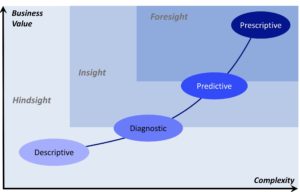
By Chris Potts
September 2019
Advanced Portfolio Management: Goals-Driven Investment in Change
Why your Portfolio Managers, Enterprise Architects and Business Analysts are now more valuable than ever
The world of business change just keeps on changing. Turning goals into outcomes at market-speed, through dynamic and co-ordinated investments, is now core to every enterprise’s choices and results. Change Portfolios must be goals-driven, agile, extroverted and efficient. Traditional portfolios – projects-driven, static, and often introspective – are becoming constraints on enterprise performance. It’s time to innovate, transform, and build on the platform they created. Portfolio Managers, Enterprise Architects and Business Analysts are at the heart of that journey, working closely together as one investment-focused team.
Innovating in How We Create Outcomes from Change
The way your enterprise operates, the outcomes it produces and how much that costs, are cumulative results of all the changes that have happened since the day that it came into being. That your enterprise exists, and is achieving its goals, shows how well it has invested in change, and created whatever value was needed.
Some of those changes worked better than others, and some didn’t work at all. Change, like anything we invest in, is a risky business. The collective performance of changes matters more than the success-rate of individual initiatives. Being excellent at investing in change is about enterprise-wide portfolio management.
The world of change is continually changing, so we need to keep innovating in our change-related methods and roles. Sometimes, incremental innovations are all that are needed, other times only breakthrough advances will do. When our approach is beginning to constrain our performance, it’s time to rethink, redesign and upgrade it. Doing the same things better or quicker, will not be enough to keep-up with the times.
Change is Accelerating, Outside-In
Speed, at turning ideas into outcomes, has become vital for success at investing in change. Markets transform, and customer choices evolve, faster than many enterprises are capable of changing, yet slower than others would prefer. Getting out-of-sync with the market, one way or the other, is now more likely than ever and will soon show up in our business results.
Take a look at the changes you invest in today. How many are rooted in ideas and outcomes ‘out there’ in the market, rather than ideas that come from within? For those of us old enough to remember, changes used to be mostly introspective, such as streamlining internal processes, re-organising activities and departments, and upgrading computer systems. Now, most have to be extroverted – dealing with market transformations, customer experiences, fluid external processes, technological revolutions, regulatory changes, and so on.
That shift, from introspective to extroverted change, has exploded both the volume and diversity of ideas for investment, and the risk of our changes fragmenting. This new wealth of choices favours those who know best how to filter and value them, to co-ordinate changes as an efficient portfolio, and fit them together as a coherent enterprise structure. The portfolio’s performance is the ‘proof of the pudding’ – measured by the goals we achieve, the risks we incur, total resources we use, and what impact it all has on our operating costs. A projects-driven portfolio cannot tell us that story, the data are simply not there. If that is what we are currently using, it is time to transform to goals-driven change.
From Projects-Driven to Goals-Driven Investment in Change
The value of the changes we invest in, is in how much they contribute to our goals. Together, they must deliver the outcomes we need – and no more – with the minimum totals of risks and resources. As the principles of portfolio management are there to remind us, the benefits, costs and risks of each change must be considered in context of the portfolio as a whole. The most attractive individual investments are not always the best ones to invest in.
A projects-driven portfolio kick-starts our journey to excellence at investing in change. It doesn’t end there. Choosing and managing projects, and the resources they collectively need, are essential first-steps to what follows. Goals, not projects, need to drive our portfolio. Even the idea of a traditional project, as the primary vehicle for change, is itself being challenged by more flexible and speedy approaches. Our portfolio cannot be driven by specific change methods, whether projects or anything else, so it can equally handle them all.
The longer our enterprise uses a projects-driven portfolio, the more likely that solution will become the constraint. To build on the platform it created, and before the value of portfolio management fails to move with the times, we need to upgrade to the next-generation portfolio, and beyond. Who should we expect to lead that journey, and to manage our portfolio’s performance?
Your Next-Generation Change Portfolio Team
Executives govern the enterprise’s performance at creating value though investments in change. They set the investment goals and priorities, choose the portfolio of changes to invest in, and monitor the outcomes produced.
They are likely to delegate day-to-day management of their Change Portfolio, to a relatively small and multi-disciplined team. In many organisations today, the roles that team comprises are most-often found in IT. Where they are located is much less important than the purpose they represent, the connections and influence they have, and their understanding of the enterprise and its culture. Here are the people that make-up that team, and what they ‘bring to the party’:
Portfolio Managers
Co-ordinating the outcomes that changes deliver – to achieve the portfolio goals, with the least-possible risks and resources, and with the best probabilities of success.
Enterprise Architects
Fitting-together individual changes – to deliver the agreed ‘big picture’ blueprint, and transform the enterprise in-sync with the market.
Business Analysts
Filtering and defining the best changes to invest in, from a diverse range of ideas and options – to deliver the contributions the portfolio requires, at the speed with which they are needed.
So, in today’s high-paced, diverse and extroverted world of change, your Portfolio Managers, Enterprise Architects and Business Analysts are central to your capabilities for investing in change, and more valuable than ever before. It is vital they are working as one team, are linked-into the structure for implementing change, while remaining autonomous from implementation itself. There is a creative tension needed between investment and implementation, for portfolio management to function properly.
And if you are still using a projects-driven portfolio, it’s time your Change Portfolio team transformed it to goals-driven. That way, you can continue to achieve your enterprise goals, at the speed you need to achieve them, given all the ideas and changes that keep happening out-there in the market.

